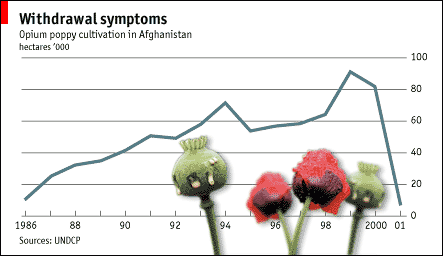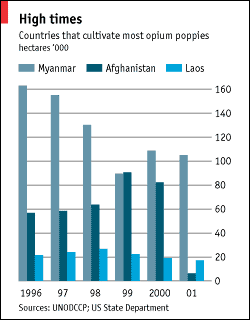A drug on the market
The Economist . 27 February 2002
A report from a United Nations body has added to mounting worries about an upsurge in heroin trafficking, following the downfall of Afghanistan’s Taliban regime. The Taliban imposed a largely effective ban on the cultivation of the opium poppy, from which heroin is derived. But Afghan farmers are now planting poppies again.

NEITHER individual Afghans nor foreign governments have cause to mourn the collapse of the Taliban regime. But in one respect, it is already being missed abroad if not at home: it managed to eradicate most of Afghanistan's cultivation of the opium poppy. Now the Taliban are defeated, the country may once again reclaim the dubious honour of being the world's biggest producer, and the dominant force in the world heroin trade. Rival South-East Asian producers are now scrambling to beat them to market. Police and customs forces throughout Central Asia and Europe are bracing themselves for an influx of cheap heroin, and the United Nations (UN) International Narcotics Control Board, in its annual report, published on Tuesday February 26th, appealed for international action “to assist Afghanistan in preventing the resumption of illicit opium poppy cultivation.”
In 1999, Afghanistan produced four-fifths of all the illicit opium grown
in the world. It was the source for almost all the heroin used in neighbouring
countries, perhaps as much as 80% of that sold on the streets of Western
European countries, and up to 90% of the market in some, such as Britain.
But in September 1999, the Taliban issued a decree ordering all poppy
farmers to cut the area under cultivation by a third. In fact, the actual
reduction achieved was probably only about a tenth. But, coupled with
a severe drought the next year, it had the effect of bringing total production
down by 28%.
But in post-Taliban Afghanistan, there is a wealth of anecdotal evidence
suggesting that opium production will surge again: in many areas, though
spring has barely begun, large poppy fields can be seen; customs forces
in neighbouring countries such as Tajikistan have already made large seizures
of heroin—which the INCB blames on the release of stocks stored through
the war. Askar Akayev, the president of Kirgizstan, has said he expects
“a huge influx” of heroin, as this year's harvest is processed
in a few months' time.
There are a number of reasons why the opium poppy proved such a popular
crop in Afghanistan in the 1980s and 1990s, and why fears that it will
reassert itself are well-founded. Opium has been cultivated and consumed
for centuries in Afghanistan—though only during the war that began
in 1979 did it become such an important crop. Second, other countries
in the region, such as Iran, after the Islamic revolution in 1979, Turkey
and Pakistan, eliminated much poppy production. Third, the war led to
the degradation of other forms of agriculture, as well as of most economic
infrastructure. It also generated a demand for weapons from various warring
factions, for whom heroin was a way of financing arms purchases, especially
in the 1990s, after the end of the Soviet occupation led American and
other supporters of Afghan mujahideen to turn off the financial tap.
Most important, the war led to a breakdown of central government control,
so that, even had the government in Kabul wanted to stop heroin production,
it did not have the means to do so. The fear now is that that describes
precisely the predicament of the interim Afghan administration led by
Hamid Karzai. An uneasy coalition of returned royalist exiles and the
armed opposition to the Taliban, it relies on the support of local warlords
and power-brokers. It has, as yet, few police or soldiers of its own,
and Mr Karzai has been rebuffed in his requests for a larger foreign peacekeeping
force with a mandate that extends beyond Kabul. He does not have the resources
to enforce what would be an extremely unpopular ban on opium cultivation.
For many farmers trying to rebuild their lives after so many years of
warfare, this is the cash-crop of choice.
 In some places,
efforts have been made to curb production: in Kandahar, the Taliban's
stronghold in the south, and centre of a big poppy-growing area, the government
held a public bonfire of opium earlier this month, and closed down the
city's opium bazaar, which had survived the Taliban. But it seems
that, even there, the market has simply moved rather than shut up shop.
In some places,
efforts have been made to curb production: in Kandahar, the Taliban's
stronghold in the south, and centre of a big poppy-growing area, the government
held a public bonfire of opium earlier this month, and closed down the
city's opium bazaar, which had survived the Taliban. But it seems
that, even there, the market has simply moved rather than shut up shop.
News of these developments has not been lost on other opium producers,
notably those in the “Golden Triangle” area that straddles Myanmar,
Laos and Thailand. Even though it is the dry season, not the usual time
of year to be planting opium, farmers in Myanmar have been using irrigation
on a massive scale to raise the crop. They have been attracted by one
consequence of the Taliban's drug policy: a price surge. Raw opium,
at about $900 per kilo in the region now, is twice the price it was last
summer. In Afghanistan, according to the UN, farm-gate prices for fresh
opium were about $300 per kilo last year—a tenfold increase over
prices in 2000. They have risen even further since.
Of course, if there is a big harvest this year in Afghanistan, prices
will fall again. That is another reason for producers—including those
in Myanmar—to hurry to bring their crop to market. This is an alarming
prospect for countries dealing with the medical, social and political
costs of wide-scale heroin addiction. Even those who argue that this is
a problem that can only be solved by curbing demand, rather than by abortive
efforts to cut off supply, have cause to worry: whatever the strategy
for cutting demand, tumbling prices do not help.